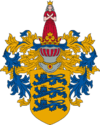Tallinn City Council
| Tallinn | |||||
|---|---|---|---|---|---|
| City | |||||

|
|||||
|
|||||
| Coordinates: 59°26′14″N 24°44′43″E / 59.43722°N 24.74528°ECoordinates: 59°26′14″N 24°44′43″E / 59.43722°N 24.74528°E | |||||
| Country |
|
||||
| County |
|
||||
| First appeared on map | 1154 | ||||
| Town rights | 1248 | ||||
| Government | |||||
| • Deputy Mayor | Taavi Aas (Centre Party) | ||||
| Area | |||||
| • City | 159.2 km2 (61.5 sq mi) | ||||
| Elevation | 9 m (30 ft) | ||||
| Population (1 March 2017) | |||||
| • City | 444,215 | ||||
| • Rank | 1st (67th in EU) | ||||
| • Density | 2,800/km2 (7,200/sq mi) | ||||
| • Metro | 542,983 | ||||
| Demonym(s) | Tallinner | ||||
| Time zone | EET (UTC+2) | ||||
| • Summer (DST) | EEST (UTC+3) | ||||
| Postal code | 15199 | ||||
| Area code(s) | (+372) 64 | ||||
| Vehicle registration | A-B | ||||
| GDP(nominal) | 2014 | ||||
| - Total | €10($13) billion | ||||
| - Per capita | €23,000($30,000) | ||||
| Website | www.tallinn.ee | ||||
| Historic Centre (Old Town) of Tallinn | |
|---|---|
| Name as inscribed on the World Heritage List | |
 |
|
| Location | Estonia |
| Type | Cultural |
| Criteria | ii, iv |
| Reference | 822bis |
| UNESCO region | Europe and North America |
| Inscription history | |
| Inscription | 1997 (21st Session) |
| Largest ethnic groups | ||
| Ethnic group | Population (2016) | % |
|---|---|---|
| Estonians | 226,563 | 53.51 |
| Russians | 155,263 | 36.67 |
| Other, incl: | 32,988 | 7.79 |
| Ukrainians | 12,367 | 2.92 |
| Belarusians | 6,269 | 1.48 |
| Finns | 2,192 | 0.52 |
| Jews | 1,514 | 0.36 |
| Tatars | 1,062 | 0.25 |
| Lithuanians | 919 | 0.22 |
| Poles | 804 | 0.19 |
| Latvians | 764 | 0.18 |
| Germans | 642 | 0.15 |
| Unknown | 8,606 | 2.03 |
Tallinn (/ˈtɑːlɪn/ or /ˈtælɪn/,Estonian pronunciation: [ˈtɑlʲˑinˑ]; names in other languages) is the capital and largest city of Estonia. It is situated on the northern coast of the country, on the shore of the Gulf of Finland, 80 km (50 mi) south of Helsinki, east of and west of Saint Petersburg. From the 13th century until 1918 (and briefly during the Nazi occupation of Estonia from 1941 to 1944), the city was known as Reval. Tallinn occupies an area of 159.2 km2 (61.5 sq mi) and has a population of 443,894. Approximately 32% of Estonia's total population lives in Tallinn.
Tallinn was founded in 1248, but the earliest human settlements date back 5,000 years, making it one of the oldest capital cities of Northern Europe. The initial claim over the land was laid by the Danes in 1219 after a successful raid of Lyndanisse led by Valdemar II of Denmark, followed by a period of alternating Scandinavian and German rule. Due to its strategic location, the city became a major trade hub, especially from the 14th to the 16th century, when it grew in importance as part of the Hanseatic League.
...
Wikipedia



